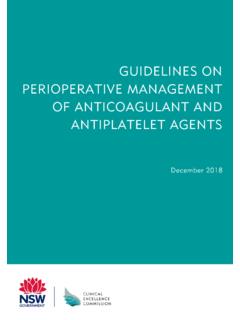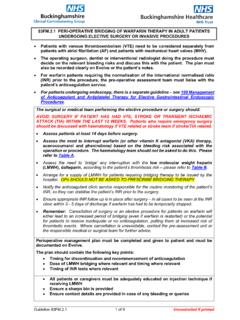Transcription of Interventional Spine and Pain Procedures in Patients on ...
1 CHRONIC AND Interventional PAIN. Regional Anesthesia & Pain Medicine: first published as on 1 April 2018. Downloaded from on October 6, 2019 by guest. SPECIAL ARTICLE. Interventional Spine and Pain Procedures in Patients on antiplatelet and anticoagulant Medications (Second Edition). Guidelines From the American Society of Regional Anesthesia and Pain Medicine, the European Society of Regional Anaesthesia and Pain Therapy, the American Academy of Pain Medicine, the International Neuromodulation Society, the North American Neuromodulation Society, and the World Institute of Pain Samer Narouze, MD, PhD,* Honorio T. Benzon, MD, David Provenzano, MD, Asokumar Buvanendran, MD, . Jos De Andres, MD,|| Timothy Deer, MD,** Richard Rauck, MD, and Marc A. Huntoon, MD . complementary updated guidelines. The authors desired coordination with Abstract: The American Society of Regional Anesthesia and Pain Med- the authors of the recently updated regional and acute pain anticoagulation icine (ASRA) 2012 survey of meeting attendees showed that existing guidelines.
2 The latest evidence was sought through extensive database search ASRA anticoagulation guidelines for regional anesthesia were insufficient strategies and the recommendations were evidence based when available and for their needs. Those surveyed agreed that procedure-specific and patient- pharmacology driven otherwise. We could not provide strength and grading specific factors required separate guidelines for pain and Spine Procedures . of these recommendations because there are not enough well-designed large In response, a guidelines committee was formed. After preliminary review studies concerning Interventional pain Procedures to support such grading. of published complications reports and studies, the committee stratified in- Although the guidelines could not always be based on randomized studies Protected by copyright. terventional Spine and pain Procedures according to potential bleeding risk: or on large numbers of Patients from pooled databases, it is hoped that they low-, intermediate-, and high-risk Procedures .
3 The ASRA regional anesthe- will provide sound recommendations and the evidentiary basis for such rec- sia anticoagulation guidelines were largely deemed appropriate for the low- ommendations. This publication is intended as a living document to be up- and intermediate-risk categories, but the high-risk category required further dated periodically with consideration of new evidence. investigation. The first guidelines specific to Interventional Spine and pain Procedures were published in 2015. Recent reviews evaluating bleeding com- (Reg Anesth Pain Med 2018;43: 225 262). plications in Patients undergoing specific Interventional pain Procedures , the development of new regional anesthesia and acute pain guidelines, and the survey was conducted among participants at the Anticoagu- development of new anticoagulants and antiplatelet medications necessitate A lation/Antiplatelets and Pain Procedures open forum held at the American Society of Regional Anesthesia and Pain Medicine From the *Western Reserve Hospital, Cuyahoga Falls, OH; Department of An- (ASRA) annual fall meeting in 2012.
4 The purpose of the survey esthesiology, Northwestern University Feinberg School of Medicine, Chicago, IL; Pain Diagnostics and Interventional Care, Pittsburgh, PA; Department was to determine the safe practice patterns of pain physicians re- of Anesthesiology, Rush University Medical Center, Chicago, IL; ||Valencia garding continuance of concurrently administered anticoagulants, University Medical School and Department of Anesthesiology Critical Care timing schedules for cessation and resumption of use, and any use and Pain management , General University Hospital, Valencia, Spain; ** Spine of bridging therapies when planning for various Interventional and Nerve Center of The Virginias, Charleston, WV; Carolinas Pain Institute, Winston-Salem, NC; and Department of Anesthesiology, Virginia Commonwealth pain Procedures . The survey items included specific practice char- University, Richmond, VA.
5 Acteristics and whether active protocols were utilized. In addition, Accepted for publication September 1, 2017. the survey queried the frequency of adherence to specific ele- Address correspondence to: Samer Narouze, MD, PhD, Center for Pain ments of the current ASRA practice guidelines for regional anes- Medicine, Western Reserve Hospital, 1900 23rd St, Cuyahoga Falls, OH. 44223 (e mail: thesia and/or if respondents incorporated different protocols for Brian D. Sites, MD, was acting Editor-in-Chief for this submission. different pain is a paid member of an advisory board for Abbott Laboratories. One hundred twenty-four active participants attended the open receives research funding from Abbott Laboratories and Medtronic. He forum. Responses were collected using an audience response system. serves as a consultant to Abbott, Boston Scientific, Medtronic, Nevro, and Halyard.)
6 Is a paid consultant for Axonics, Abbott, Bioness, Flowonix Eighty-four percent of respondents were anesthesiologists, and the Medical, Jazz Pharmaceuticals, Nalu, SpineThera, Saluda Medical, remainders were physical medicine and rehabilitation physicians, Mainstay Medical, Vertos, Vertiflex. receives funding from Boston neurologists, orthopedic surgeons, and neurological surgeons. Scientific, Biodelivery Science Inc, and Jazz Pharma. In addition, The vast majority of respondents (98%) followed ASRA re- receives ongoing research grants from Nektar, Biogen, Pfizer, SPR. Therapeutics, Neuros, Mainstay, Saluda, Nevro, and Stimwave and also gional anesthesia guidelines for anticoagulants but not for anti- serves as chair of Data Safety Monitoring Boards and Clinical Events platelet agents. Two-thirds of the participants (67%) had separate Committee of Mainstay and Saluda trials.
7 He also serves as a speaker for protocols regarding aspirin (acetylsalicylic acid [ASA]) or nonste- AstraZeneca. serves on the Clinical Events Committee for a study roidal anti-inflammatory drugs (NSAIDs). Moreover, 55% stopped funded by Saluda Medical Americas, Inc. and the Data Safety Monitoring Committee for a study funded by Mainstay Medical International PLC. He ASA before spinal cord stimulation (SCS) trials and implants, and otherwise declares no potential conflicts of interest. The other authors 32% stopped ASA before epidural steroid injections (ESIs). How- declare no conflict of interest. ever, 17% admitted that they used different protocols for cervical and equally contributed to the manuscript. Spine injections as compared with lumbar Spine injections. Most Copyright 2017 by American Society of Regional Anesthesia and Pain Medicine did not express familiarity with selective serotonin reuptake inhib- ISSN: 1098-7339 itors' (SSRIs') effects on platelets.
8 Only 36% knew that SSRIs can DOI: lead to a bleeding disorder. Regional Anesthesia and Pain Medicine Volume 43, Number 3, April 2018 225. Copyright 2018 American Society of Regional Anesthesia and Pain Medicine. Unauthorized reproduction of this article is prohibited. Regional Anesthesia & Pain Medicine: first published as on 1 April 2018. Downloaded from on October 6, 2019 by guest. Narouze et al Regional Anesthesia and Pain Medicine Volume 43, Number 3, April 2018. Based on these results, the need for separate ASRA guide- The ASRA regional anesthesia and acute pain guidelines lines, specifically for Interventional Spine and pain Procedures in may be appropriate for the low- or intermediate-risk category, but Patients on antiplatelets/anticoagulants, was self-evident. The Board the high-risk targets require a more intensive look at the issues spe- of Directors of the ASRA recommended that the Regional Anesthesia cific to patient safety and improved outcomes.
9 And Pain Medicine appoint a committee to develop separate guide- For example, SCS lead placement requires the use of large- lines for pain The committee has an international rep- gauge needles with a long bevel and stiff styletted leads to enhance resentation and was endorsed by the European Society of Regional directional control. In many cases, the technique is simple with lit- Anesthesia and Pain Therapy, American Academy of Pain Medicine, tle tissue stress. However, multiple needle and lead insertions can the International Neuromodulation Society, North American Neuro- occur, exposing the epidural space to significant ,4. modulation Society, and the World Institute of Pain. The recom- Patients with neck or back pain undergoing ESIs or other spinal mendations were published in the Regional Anesthesia and Pain interventions may have significant spinal abnormalities including spi- Medicine in nal stenosis, ligamentum flavum hypertrophy, spondylolisthesis, or These recommendations were timely as there has been a spondylosis, which may compress the epidural venous plexus within growing interest in this topic spanning several years, as evidenced tight epidural ,10 Moreover, Patients , after various Spine sur- by the recent publications of cases of epidural hematoma during geries, may develop fibrous adhesions and scar tissue, thus further Interventional pain Procedures in Patients receiving antiplatelet compromising the capacity of the epidural space and distorting the agents (ASA and NSAIDs).
10 3 5 anatomy of the epidural vessels. The risk of bleeding is further in- The current ASRA guidelines for the placement of epidural creased in pain Patients taking several concomitant medications with and spinal catheters do not recommend cessation of these antiplate- antiplatelet effects including NSAIDs, ASA, and serotonin reuptake let agents for epidural Procedures , nor do the guidelines differentiate inhibitors (SRIs).2. between Interventional pain Procedures and perioperative regional The major update to Table 1 compared with the first publica- anesthesia tion is the addition of lumbar facet medial branch nerve block The development of new anticoagulants and antiplatelet (MBNB) and radiofrequency ablation (RFA) to the low-risk pro- medications as well as the recent publications evaluating bleeding cedure category based on a recently published review.


